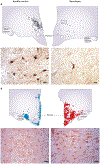Interactions of the histamine and hypocretin systems in CNS disorders
- PMID: 26100750
- PMCID: PMC8744538
- DOI: 10.1038/nrneurol.2015.99
Interactions of the histamine and hypocretin systems in CNS disorders
Abstract
Histamine and hypocretin neurons are localized to the hypothalamus, a brain area critical to autonomic function and sleep. Narcolepsy type 1, also known as narcolepsy with cataplexy, is a neurological disorder characterized by excessive daytime sleepiness, impaired night-time sleep, cataplexy, sleep paralysis and short latency to rapid eye movement (REM) sleep after sleep onset. In narcolepsy, 90% of hypocretin neurons are lost; in addition, two groups reported in 2014 that the number of histamine neurons is increased by 64% or more in human patients with narcolepsy, suggesting involvement of histamine in the aetiology of this disorder. Here, we review the role of the histamine and hypocretin systems in sleep-wake modulation. Furthermore, we summarize the neuropathological changes to these two systems in narcolepsy and discuss the possibility that narcolepsy-associated histamine abnormalities could mediate or result from the same processes that cause the hypocretin cell loss. We also review the changes in the hypocretin and histamine systems, and the associated sleep disruptions, in Parkinson disease, Alzheimer disease, Huntington disease and Tourette syndrome. Finally, we discuss novel therapeutic approaches for manipulation of the histamine system.
Figures






References
-
- von Economo C Sleep as a problem of localization. J. Nerv. Ment. Dis 71, 249–259 (1930).
-
- Peyron C et al. A mutation in a case of early onset narcolepsy and a generalized absence of hypocretin peptides in human narcoleptic brains. Nat. Med 6, 991–997 (2000). - PubMed
-
- American Academy of Sleep Medicine. International Classification of Sleep Disorders: Diagnostic and Coding Manual 3rd edn (AASM, 2014).

